D.E. Mathre, R.H. Johnston, and W.E. Grey
Department of Plant Sciences and Plant Pathology, Montana State University, Bozeman, MT 59717
Mathre, D.E., R.H. Johnston, and W.E. Grey. 2001. Small Grain Cereal Seed Treatment. The Plant Health Instructor. DOI: 10.1094/PHI-I-2001-1008-01. Updated 2006.
Introduction
Some of the biggest success stories in plant disease control involve the use of seed treatments, particularly of small grain cereals, e.g., wheat, barley, and oats. These seed treatments are composed of fungicides that have a variety of chemistries. They generally are low in toxicity to plant and animal life, and because they are applied in low doses, they have little environmental impact. In some cases these doses are as low as 1 g of active ingredient per hectare (0.4 g per acre). As a result of these low doses, the cost per hectare to a grower tends to be fairly low, usually less than $5 per hectare and often less than $2.50 per hectare ($1/acre). Regardless of the yield potential of the planted crop, application of seed treatment is one of the least expensive choices a grower can make. Often, growers who farm in areas of low productivity may be tempted to forgo application of a seed treatment. This is usually a mistake since it is these very growers who cannot afford any yield or quality losses due to a plant disease.
Another major impact that seed treatments have had on the small grain industry is their effect on plant breeding. In the early part of the 20th Century, many wheat breeders spent a considerable portion of their effort on breeding for resistance to common bunt. Today, with this disease controllable with seed treatment they are able to spend their efforts on breeding for other attributes, i.e. grain quality.
This lesson will introduce you to the history of small grain seed treatments, the diseases they are capable of controlling, the various chemistries used, and their mode of action
Historical Aspects
The history of seed treatment goes back over 300 years (1, 8). In 1670 a ship carrying wheat grain went down off the coast of England near the city of Bristol. Evidently, the ship was close enough to shore that nearby farmers were able to retrieve some of the grain. Having been soaked in sea water, the grain was not fit for processing into flour, but some farmers planted it. The crop that resulted was remarkably free of "smut", whereas most of the fields planted with grain that had not been soaked in seawater showed heavy smut infestation.
Over the next 100 years, various people tried treating wheat seed with salt, lye, urine, etc. to see if they could reduce the amount of smut that developed. Use of a salt/brine mixture was known in various parts of Europe. The French botanist Tillet published an article on this in 1770 indicating that treating seed with such materials would reduce the amount of smut. In 1807, the Swiss scientist Prevost showed that treating smut spores with a liquid solution of copper sulfate inhibited their germination. Over the next 100 years, recommendations were issued to treat wheat seed with copper sulfate to reduce the infection with common bunt. However, this compound is a general biocide and much injury to seed germination was noted. In 1895, the use of formaldehyde was suggested by the Germans. It gained in popularity due to its effectiveness and low cost but certainly was not pleasant nor safe to use for the person treating the seed.
In 1912, organic mercury compounds were tried in Germany and found to be quite effective in controlling common bunt. However, initially they were too expensive to use and also had to be applied as a liquid that left the grain too wet to use without drying. By 1917, research on other compounds showed that copper carbonate was safer to use than copper sulfate and could be applied as a dry powder formulation. This treatment was first used in Australia and was soon adopted in the United States. However, one disadvantage of the dry treatment was the dust problem that developed put the person treating the seed at risk. This soon led to tests with "slurries", whereby the dust formulation was mixed with a small amount of water and added to the seed. This helped increase the "coverage" of the seed without wetting it too much.
After the initial discovery of the value of organic mercuries for seed treatment in 1912, additional work continued on them. The first commercial formulation called Panogen (= methylmercury guanidine) was developed in Sweden in 1938. Panogen was available as a liquid and beginning in 1948 was widely used in the United States. Later, a dust formulation of ethylmethyl mercury (= Ceresan) was developed and was also widely used in treating small grains. The organic mercury seed treatments were highly effective against common bunt and were so inexpensive that many seed elevators and/or treating stations would apply them for no cost when the farmer brought in his/her seed to be cleaned. Even when a cost was incurred, it usually was no more than 10-15 cents per bushel of seed. The use of the mercury fungicides continued until the 1970's when concern developed over their toxicity to man and other animals. Residues of these mercury seed treatments were found in game birds that had eaten treated seed that had blown off trucks or had spilled on the ground near seed treating stations. In addition, several unfortunate incidents of human poisoning occurred from people eating treated grain directly, or eating meat from animals that had consumed treated grain. These poisonings finally sealed the fate of the organic mercury fungicides and today they are no longer used in the United States and have limited use in other parts of the world.
With the loss of the mercury seed treatments, great concern developed that suitable replacements (based on both cost and effectiveness) would not be found. However, this was also the time that the first systemic fungicide was discovered and developed into a commercial formulation. This new compound, called carboxin, was found to control loose smut of wheat and barley as well as common bunt of wheat. The ability of carboxin to control loose smut was unique since the loose smut pathogen survives from one season to the next inside of the seed as hyphae in the embryo. To reach these hyphae, a fungicide would need to penetrate into the seed itself or into the developing seedling. Carboxin did have this systemic quality, plus it was very inhibitory to the smut fungi. The Uniroyal Chemical Company formulated carboxin with another fungicide, thiram, into a product today known in the United States as Vitavax 200. More recently, other systemic chemicals have been used and will be discussed below. Today, the small grain producer has a wide array of compounds to choose from that are capable of providing excellent control of diseases, not just common bunt or loose smut.
Other seed treatments of historical note include the development and use of hexachlorobenzene (= HCB) for common bunt control in wheat (9). This material was especially important in the Pacific Northwest where soilborne inoculum of common bunt was a factor in the disease cycle. In other areas, seedborne inoculum was the only inoculum of importance. Many of the fungicides available in the 1940's were effective in controlling the seedborne teliospores of this pathogen, but not the soilborne teliospores. HCB, however, did have the ability to control the soilborne phase of this disease and became the seed treatment of choice in 1945 throughout the Pacific Northwest. It finally it was replaced by carboxin in the 1980's.
Another historical seed treatment of an entirely different nature was the use of hot water (7). Prior to the development of carboxin, control of loose smut was impossible with chemicals. Because of its serious nature, growers needed another method of destroying the internal mycelium within the embryo of wheat and barley seeds. In 1888, the use of a hot water treatment was proposed by the Danish seedsman, J. L. Jensen. Basically, this process involved soaking the seed for 110 minutes in water held at 48 C, or 95 minutes at 49 C. As you can imagine, this process did not allow one to treat large quantities of seed, and you had the problem of drying it after treatment. Hence, it was used primarily to treat certified seed. It continued to be used up until the advent of carboxin around 1970.
Diseases Controlled by Seed Treatment
Table 1. Disease and pathogens of small grain cereals amenable to control with seed treatment fungicides
Covered Smut
|
Ustilago hordei
| Barley, Oats
|
|---|
Common Bunt
| Tilletia laevis, T. tritici
| Wheat |
Dwarf Bunt
| Tilletia Controversa
| Wheat
|
Loose Smut
| Ustilago nuda, U. avanae
| Wheat, Barley, Oats
|
Barley Stripe
| Pyrenophora graminea
| Barley
|
Seed Decay
| Pythium spp.
| Wheat, Barley, Oats
|
Browning Root Rot
|
Pythium spp.
| Wheat, Barley, Oats
|
Dry Seed Decay
| Penicillium spp.
| Wheat, Barley, Oats
|
Bare Patch
| Rhizoctonia solani AG8
| Wheat, Barley
|
Dryland Root Rot
| Fusarium culmorum F. graminearum
| Wheat, Barley
|
Common Root Rot
| Cochliobolus sativus
| Wheat, Barley
|
Take-All
| Gaeumannomyces graminis
| Wheat, Barley, Oats
|
Common Bunt - Historically, this is the disease of wheat that has been of most interest from the standpoint of control via seed treatment. It is caused by two species of
Tilletia, T. tritici (=
T. caries), and
T. laevis (=T. foetida) (3). The disease cycle of each is identical. Both are widely distributed but
T. laevis is more prevalent in the Midwestern and eastern portions of the country, while
T. tritici is more common in the western sections.
Common bunt is characterized by the formation of bunt balls in the heads of infected plants that when crushed release thousands of dark teliospores that appear black in mass. (Figure 1) They also smell of rotting fish, hence the name "stinking smut" is also attached to the name common bunt. When the teliospores are released from the bunt balls during harvest (Figure 2), they contaminate healthy seed or fall on the soil where they can survive for 10 years or more. Infection occurs from seedborne or soilborne teliospores near the soil surface. Cool temperatures during seed germination favor teliospore germination and infection of the seedling. While the seedborne inoculum of common bunt is fairly easy to control with seed treatment, it is the soilborne phase that is more difficult to control. HCB was especially effective in this regard, but now the new systemic fungicides are very effective against both the seedborne and soilborne inocula (2, 3). For more information on common bunt, consult: Mathre, D.E. 2000.
Stinking smut (common bunt) of wheat. The Plant Health Instructor. DOI: 10.1094/PHI-I-2000-1030-01.
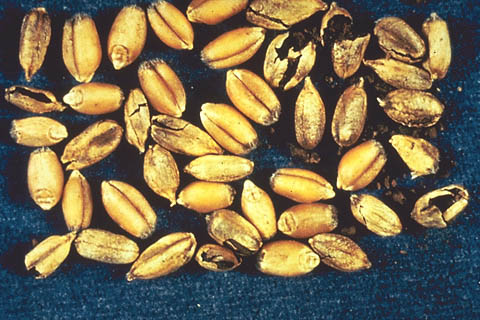
Figure 1 |  Figure 2 |
Dwarf Bunt - Dwarf bunt is a disease strictly of winter wheat grown under long snow cover, but has been found to infect winter barley under experimental conditions. It is characterized by plants that are highly dwarfed in size, perhaps being only ¼ the size of a healthy plant (3). Infected heads are filled with bunt balls in the same manner as common bunt (Figure 3) However, the bunt balls in dwarf bunt tend to be more round than those of common bunt which are oblong (Figure 4). The teliospores are released during harvest to contaminate the soil where the spores can survive many years, probably 10 or more.

Figure 1 |

Figure 2 |
Infection of the plant occurs long after seed germination when the plant is in a dormant condition under snow cover. The teliospores germinate when the temperature is near freezing and the relative humidity is near 100%. Such conditions normally occur only under snow cover. Therefore, dwarf bunt is known to mainly occur in locations where snow stays on the ground for at least 60 days during the winter, e.g., high mountain valleys. Since infection occurs long after the seed germinates, control of this disease via seed treatment has been very difficult and erratic until recently with the introduction of difenoconazole (= Dividend) (5, 10). This compound provides nearly complete control of dwarf bunt when applied as a seed treatment.
Covered Smut - This disease of barley and oats is caused by
Ustilago hordei. Kernels and glumes of infected plants are replaced by teliospores that are surrounded by an intact membrane (Figure 5). Hence the name "covered smut". This membrane breaks down during the harvest operation to spread the teliospores to nearby healthy grain and onto the soil surface. Infection of new seedlings is primarily from seedborne inoculum since most seed treatment fungicides, even nonsystemic fungicides, provide excellent control of this disease.
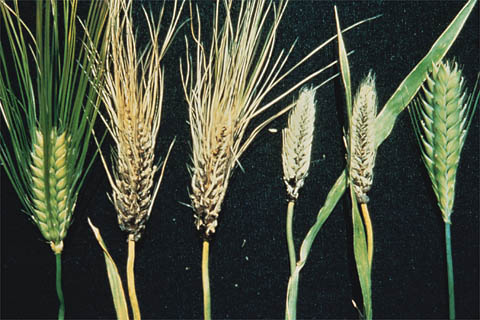
Figure 5
Loose Smut - Loose smut infects wheat and barley and is caused by
Ustilago tritici and U. nuda, respectively. Loose smut of oats is caused by
U. avenae. This disease is characterized by the development of teliospores in the head that are surrounded initially by a very thin membrane that breaks down soon after teliospore formation such that the spores can be windblown to nearby healthy plants during flowering (Figure 6). Teliospores land on the stigma of an open flower, germinate, and the infection hyphae penetrate into the developing seed. It survives from one growing season to the next as mycelium in the embryo of a seed (Figure 7). While this mycelium does not harm the embryo, this does serve as a source of inculum to infect the seedling when the seed germinates. Because of the internal nature of the seedborne inoculum, control of loose smut was limited to the hot water treatment prior to the development of systemic fungicides. Carboxin was the first to be developed for control of loose smut, but today several of the DMI (sterol inhibiting) fungicides also provide control.

Figure 6
| 
Figure 7 |
Barley Stripe - This disease occurs only on barley and is caused by
Pyrenophora graminea. The inoculum is seedborne, usually as mycelium within the "husk" tissue of the barley seed. Infection of the seed occurs the previous growing season when conidia are blown from sporulating areas on infected leaves into the head where the new seed is developing. Infected plants show brown linear lesions in the developing seedling leaves, usually when the 3-5 leaf has emerged (Figure 8). Plants are stunted, and the developing leaves become tattered as the leaves are whipped by the wind. Heads on infected plants often are "trapped" in the leaf sheath and only partially emerge (Figure 9). Grain in such heads is greatly shriveled and often discolored brown. Control of barley stripe became possible with the advent of the DMI fungicides with imazalil providing complete control.
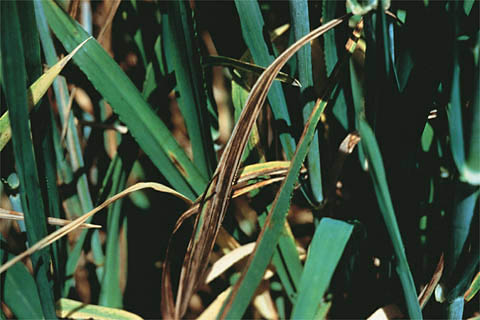
Figure 8 | 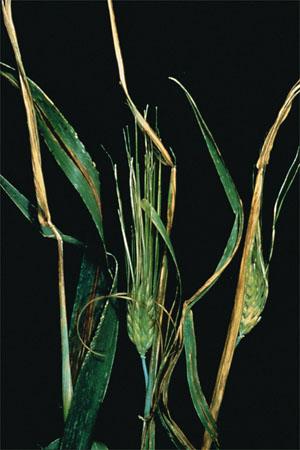 Figure 9 |
Dry Seed Decay - Dry seed decay occurs when seed is planted into soil too dry to allow for germination of the seed. Often this is done with the hope that rains will come to stimulate seed germination. However, when the seed sits in dry soil for 6-8 weeks prior to germination,
Penicillium spp. will often infect the resting seed and destroy its ability to germinate. Such infected seed often appears blue due to the growth of the Pencillium fungus (Figure 10).
 Figure 10
Figure 10 Control of dry seed decay can be accomplished with a variety of fungicides, including some of the older materials such as captan, maneb, thiram, or mancozeb. Somewhat better control occurs with use of the DMI fungicides, with imazalil perhaps being the best known for activity in this regard.
Seed Decay/Browning Root Rot - This disease is caused by one or more
Pythium spp. It is characterized by decay of the seed prior to or shortly after germination. If the plant emerges, infection of fine roots occurs resulting in the "browning root rot phase" (Figure 11). In this case, the plants are stunted and often show yellowing of lower leaves. The pathogen survives as oospores in the soil and infection occurs when the environmental conditions are conducive, e.g., high soil moisture and cool temperatures. Seed treatment to control seed decay has been with materials as captan, thiram, mancozeb, and maneb but to date, the most effective material is metalaxyl. The browning root rot phase is more difficult to control and only systemic materials such as metalaxyl will have any impact on the disease. This is due in part to the fact that when fungicides are applied as a seed treatment they are translocated upward from the treated seed and not down into the roots.
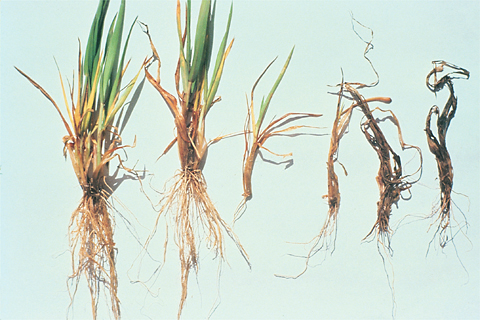
Figure 11
Bare Patch - Bare patch is caused by
Rhizoctonia solani Anastomosis Group 8 and is most severe on barley. Symptoms are chlorotic stunted plants that often appear in patches in the field, hence the name "bare patch" (Figure 12). Infected roots are characterized by "spear tipping" which is quite diagnostic for this disease (Figure 13). The disease is most severe when seed is planted into a field where the previous crop of small grains has been sprayed with the herbicide Roundup or killed by disking. Infection originates from hyphae and/or microsclerotia on plant debris. In this case, the mycelium moves from the dying plants to newly developing seedlings. Control of bare patch by seed treatment with DMI fungicides has provided some control of bare patch in barley.
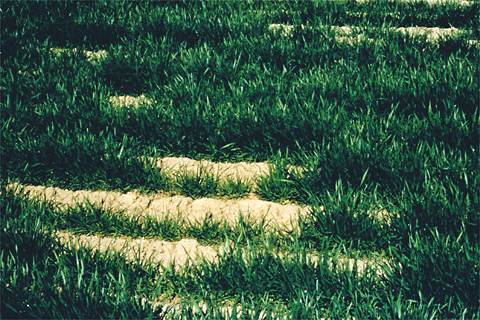
Figure 12 | 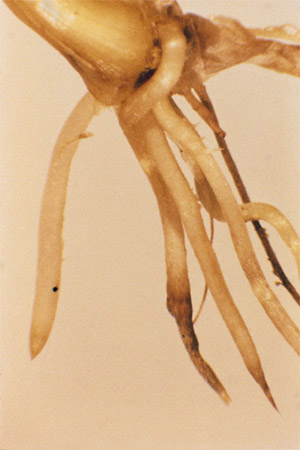
Figure 13 |
Dryland Root Rot -
Fusarium culmorum and
F. graminearum both are involved in causing dryland root rot of wheat and barley. This disease is especially important in the Pacific Northwest and the Northern Great Plains under dry conditions. Symptoms are brown culms just above the point of seed attachment upwards for 10-20 cm (Figure 14). Later, infected plants may develop white heads if drought conditions develop. The disease is made more severe when excess nitrogen is available to the plant. In this case, the excess nitrogen stimulates both root development and extensive dark green foliage. Both cause the plant to use water early in its growth that results in a plant stressed for water later in the season if timely rains do not occur. Seed treatment to control dryland root rot is partially successful with DMI systemic fungicides. Complete control is problematic since infection occurs over a long period of the plant's life.
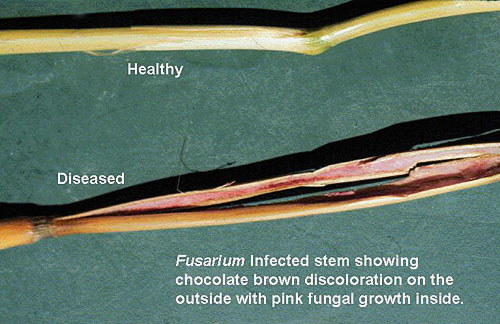
Figure 14
Common Root Rot - This disease of wheat and barley is caused by
Cochliobolus sativus. It gets its name because this pathogen is commonly found in most small grain fields. It is sometimes confused with dryland root rot since it often shows up when conditions are dry. Infection occurs from the thickwalled conidia that survive on plant debris. The main symptoms of common root rot are dark brown lesions on the subcrown internode (Figure 15) and on crown tissue. The subcrown internode is that part of the plant just above the seed, but below where crown roots emerge. However, the lesions rarely extend above the soil surface as they do with dryland root rot caused by
Fusarium spp. Infected plants usually have fewer tillers than healthy plants and the grain on infected plants may be shriveled. Seed treatment to control common root rot is similar to that for dryland root rot. The DMI systemic fungicides are the best, but even their control is only partial.
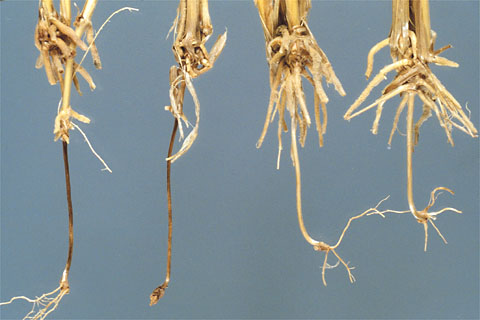
Figure 15
Take-all - Take-all is caused by
Gaeumannomyces graminis var. tritici in wheat and barley. This is a disease of wet soils from high rainfall or irrigation. Infection originates from hyphae growing from previously infected residue in the soil. Infected roots are black and prone to easy breakage when the plants are pulled from the soil (Figure 16). Infected plants usually appear in patches (Figure 17), and are stunted with white heads. Infected plants often produce little or no grain, hence the name "take-all", but if grain is produced, it is often shriveled. Control of take-all using seed treatment has been very problematic but with the advent of the DMI fungicides, several have shown some modest activity in controlling this disease. Triadimenol is perhaps the best known for its activity against take-all, with difenoconazole also showing some activity. For more information on take-all, consult: Bockus, W.W. and N.A. Tisserat. 2000.
Take-all root rot. The Plant Health Instructor. DOI: 10.1094/PHI-I-2000-1020-01.

Figure 16 |
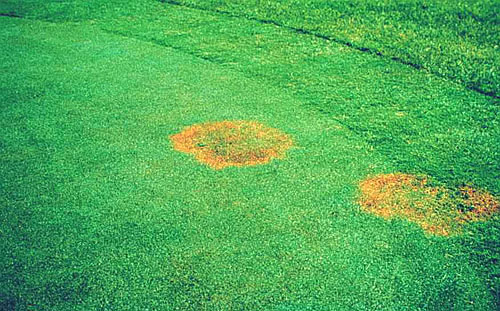
Figure 17 |
Chemicals used as Seed Treatments & their Mode-of-Action
The chemicals currently used as small grain cereal seed treatments are listed in
Table 2 with their more widely recognized "brand" names given in
Table 3. Their mode-of-action is given in
Table 4 (6) beginning with the newest and ending with the oldest. They involve a variety of "chemistries" and modes of action. The older compounds, thiram, maneb, mancozeb, PCNB, and captan all have fairly nonspecific modes of action disrupting a number of enzymes crucial for metabolism. The first systemic fungicide discovered, carboxin, inhibits mitochondrial function by disrupting the TCA cycle. More specifically, carboxin acts on the complex II of succinic dehydrogenase. Thiabendazole arrests nuclear division by interfering with microtubule assembly. This occurs when thiabendazole binds to the protein tubulin. Metalaxyl, the systemic fungicide that only affects the Oomycetes, is known to inhibit the incorporation of uridine into RNA, i.e. RNA synthesis. The turnover of ribosomal RNA deprives the cell of its ribosomes causing protein synthesis to decrease. The latest and most interesting fungicides are those that inhibit sterol biosynthesis since they are very effective at relatively low dosages, are systemic in plants, and are quite effective in controlling a variety of fungal pathogens. These compounds inhibit demethylation (DMI) at position 14 of lanosterol or 24-methylene dihydrolanosterol which are precursors of sterols that are important in membrane function. Finally, fludioxonile inhibits accumulation and incorporation of glucose and mannose into hyphal wall glucans, thus impairing membrane bound transport processes. For more details, see Lyr's book (6).
Table 2. Chemical Compounds Currently used as Small grain Cereal Seed Treatments
Captan
| N-trichloromethylthio-4-cyclohexene-1,2-diarboximide
|
Carboxin
| 5,6-dihydro-2-methyl-N-phenyl-1,4-oxathiin-3-carboxamide
|
Difenoconazole
| cis,trans-3-chloro-5[4-methyl-2-(1H-1,2,4-triazole-1-ulmethyl)-1,3-dioxolan-2-yl]phenyl 4-chlorophenyl ether
|
Imazalil
| (+)-allyl 1-(2,4-dichlorophenyl)-2-imidazol-1-ylethyl ether
|
Mancozeb
| Zinc Manganese ethylenebisdithiocarbamate
|
Maneb
| Manganese ethylenebisdithiocarbamate
|
Metalaxyl
| methyl N-(2-methoxyacetyl)-N-(2,6-xylyl)-DL-alaninate
|
PCNB
| Pentachloronitrobenzene
|
Tebuconazole
| (RS)-1-(4-chlorophenyl)4,4-dimenthyl-3-(1H-1,2,4-triazol-1-ulmethyl) pentan-3-ol
|
Thiabendazole
| 2-(4-Thiazolyl)-benzimidazole
|
Thiram
| Thtramethylthiuramdisulfide
|
Triadimenol
| (1RS, 2RS; 1RS, 2SR)-1-(r-chlorophenoxy)-3,3-dimethyl-1-(1H-1,2,4-triazol-1-yl) butan-2-ol
|
Triticonazole
| (+)-(E)-5-(4-chlorobenzylidene)-2-dimethyl-1-(1H-1,2,4-triazol-1-ylmethyl) cyclopentanol
|
Table 3. Names of Seed Treatment Fungicides
Captan
| Agrosol, Agrox, Granox, Orthocide
|
Carboxin
| Vitavax
|
Difenoconazole
| Dividend
|
Fludioxonil
| Maxim
|
Imazalil
| FloPro IMZ, Double R, Deccozil, Nu-Zone, Fungaflor
|
Mancozeb
| Dithane M-45, Mankocide, Mansul, Penncozeb
|
Maneb
| DB Green, Granol NM, Trinox, Pro-Tex
|
Metalaxyl
| Apron, Allegiance
|
PCNB
| Terrachlor, Parflo, Terra-flo, Terrazan
|
Tebuconazole
| Raxil, Preventol, Tebuject
|
Thiabendazole
| TBZ, Mertect, Metasol
|
Thiram
| Arasan, Vertagard, Thiramad
|
Triadimenol
| Baytan
|
Triticonazole
| Charter
|
Table 4. Mode of Action of Seed Treatment Fungicides
Difenoconazole
| Sterol Biosynthesis Inhibitor
|
Imazalil
| Sterol Biosynthesis Inhibitor
|
Tebuconazole
| Sterol Biosynthesis Inhibitor
|
Triadimenol
|
Sterol Biosynthesis Inhibitor |
Triticonazole
|
Sterol Biosynthesis Inhibitor |
Carboxin
| Inhibits microchondrial function by disruption complex II of succinic dehydrogenase
|
Metalaxyl
| Inhibits RNA synthesis by disrupting incorporation of uridine into RNA
|
Fludioxonil
| Imairs membrane bound transport processes by inhibiting the accumulation and incorporation of glucose and mannose into hyphal wall glucans
|
Thiabendazole
| Arrests nuclear division by interfering with microtubule assembly by binding to the protein tubulin
|
Captan
| Nonspecific
|
Mancozeb
| Nonspecific
|
Maneb
|
Nonspecific |
PCNB
| Nonspecific
|
Thiram
|
Nonspecific |
Methods of Treating Seed and Factors Involved in Efficacy
The earliest methods of treating seed with fungicides were relatively crude. The first method used involved piling the seed to be treated on a solid surface and then dusting the top of the pile with the fungicide. It was then hand-mixed using a shovel until the grain appeared to be evenly coated. Later, a rotating drum (Figure 18) was used to mix the seed with dust formulations of materials such as copper carbonate. This involved mounting a barrel at an angle, such that when it was turned by hand crank, the grain would tumble back and forth thus coating itself with the fungicide.
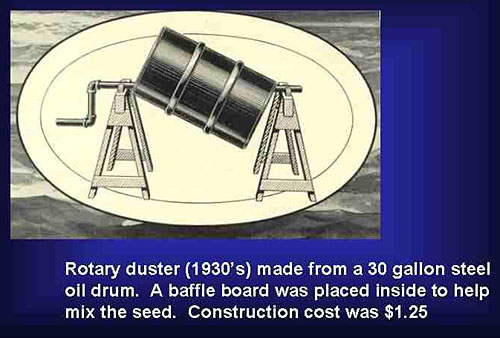
Figure 18 | 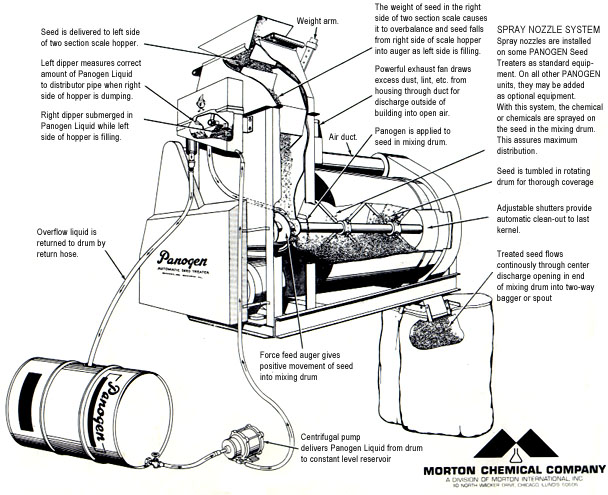
Figure 19 |
The first large seed treating machines were developed to handle the organic mercury fungicides that were available as liquids (Panogen) or dusts (Ceresan). One of these, the Panogen treater (Figure 19), dripped the liquid fungicide into a large rotating container and the seed was coated as it tumbled through the treater. Another treater, the Mist-o-matic (Figure 20), had a system whereby the liquid fungicide was dripped onto a whirling cone that caused the fungicide to become a "mist" which coated seed as it fell through this mist. Both of these treaters could handle hundreds of bushels of seed per hour so they were very efficient. Modern day treaters can handle even higher volumes of seed and operate by mixing the seed with slurry formulations of the fungicide.
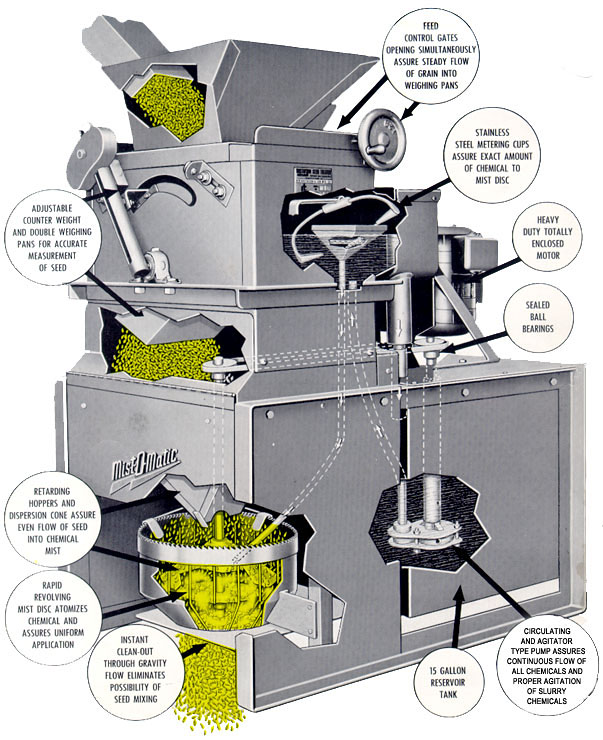
Figure 20 | 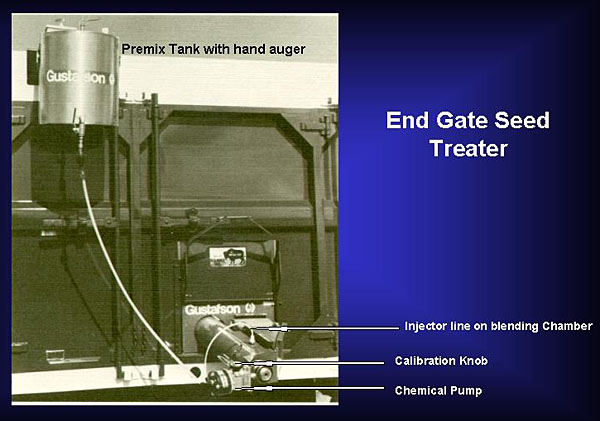
Figure 21
|
For growers who want to treat smaller lots of seed on their farm, there are a number of end-gate treaters (Figure 21). These are treaters that mount on the back of the truck carrying the seed and drip the liquid slurry formulation onto the seed as it is elevated out of the truck with an auger. The tumbling action of the seed in the auger aids in the distribution of the treatment on the seed as it moves into the grain drill.
Various factors affect the efficacy, safety, and usefulness of treated seed. One is the coverage of the seed by the fungicide. Since most of the modern fungicides do not have any vapor action, if they are to be effective, they must be placed on each and every seed. Often times when growers complain that their seed treatment has not worked it is because of poor coverage of the seed. This comes about if the treating station has not been careful in monitoring the amount of fungicide being applied, or if the equipment is operated too fast to get uniform coverage.
Another factor is safety to the operator of seed treating equipment. Those fungicides that "dust off" the seed can easily pose a respiratory problem. To reduce this risk, additives are often included with the seed treatment formulation that cause the material to stick to the seed.
Since treated seed involves a material added to the seed coat, this can affect how the seed moves through a grain drill. Sometimes, the seeds tend to stick together thus forming clumps that prevent the grain from moving smoothly through the grain drill. Again, additives can be added to the fungicide formulation to prevent seed from clumping during the planting process.
Literature Cited
1. Fischer, G. W., and C. S. Holton. 1957. Biology and control of the smut fungi. Ronald Press, New York, 622 p.
2. Hoffmann, J. A. 1971. Control of common and dwarf bunt of wheat by seed treatment with thiabendazole. Phytopathology 61:1071-1074.
3. Hoffmann, J. A. 1982. Bunt of wheat. Plant Dis. 66:979-986.
4. Hoffmann, J. A., W. G Dewey, J. E. Call, and S. M. Pine. 1983. Systemic fungicides for control of dwarf bunt of wheat. I. Seed treatment. Plant Dis. 67:294-297.
5. Keener, T, R. N. Stougaard, and D. E. Mathre. 1995. Effect of winter wheat cultivars and difenoconazole seed treatment on dwarf bunt. Plant Dis. 79:601-604.
6. Lyr, H. 1995. Modern selective fungicides. 2nd Ed. Gustav Fischer Verlag, New York, 595 p.
7. Maude, R. B. 1996. Seedborne diseases and their control: Principles and practices. CAB International, Wallingford, U. K. 280 p.
8. Neergaard, P. 1977. Seed pathology. Vol. I. The MacMillan Press, London, U. K. 839 p.
9. Purdy, L. H. 1965. Common and dwarf bunts, their chemical control in the Pacific Northwest. Plant Dis. Reptr. 60:580-583.
10. Sitton, J. W., R. F. Line, J. T. Waldher, and B. W. Goates. 1993. Difenoconazole seed treatment for control of dwarf bunt of winter wheat. Plant Dis. 77:1148-1151.
